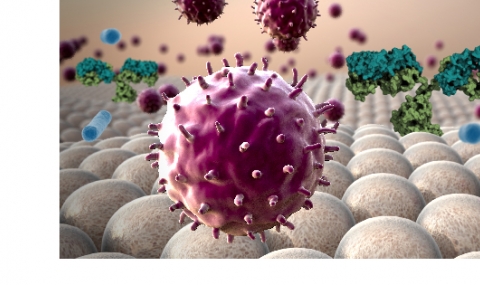1. The mechanism by which specific viral envelope proteins catalyze membrane fusion is still not fully understood. In recent years, we focused on gp41 and F, the envelope glycoproteins from HIV (retrovirus) and Sendai virus (paramyxovirus), respectively. Together with others we showed that: (i) unrelated viral families exploit similar fusion mechanisms (Peisajovich and Shai, 2003), (ii) membrane interaction induces drastic conformational changes in the fusion proteins leading to their participation in the actual membrane fusion event (Cohen et al., 2008; Sackett et al., 2006). These studies led us to propose the umbrella mechanism for virus-cell fusion. (iii) Synthetic peptides derived from regions within viral envelope proteins specifically interact with the parental envelope proteins at different stages of the fusion process, making them ideal tools for characterizing the different steps of the fusion process, as well as promising therapeutic agents (Ashkenazi and Shai, 2011; Ashkenazi et al., 2012; Ashkenazi et al., 2011) . Our finding that peptide chirality is not crucial for recognition in the cell membrane allowed us to develop new enantiomeric peptide inhibitors that specifically block infection, combining high biocompatibility with a superior stability (Faingold et al., 2013; Gerber and Shai, 2003). Furthermore, our finding that the actual membrane fusion process does not depend on peptide chirality deepens our understanding of the general mechanism by which proteins can catalyze mixing of two opposing membranes.
2. HIV utilizes different strategies to modify cellular processes and to evade the immune response. In particular, HIV employs its envelope protein to down regulate CD4+ T cells by targeting the T-cell receptor complex (TCR) through several membrane associating segments. We have shown that the fusion peptide (FP) (a hydrophobic segment located at the N-terminus of the envelope protein) plays a dual role in HIV infection: i) mediates fusion of the virus with the cell membrane (Ashkenazi and Shai, 2011; Reuven et al., 2012), ii) while down regulating T-cell responses that normally cope with viral entry (Quintana et al., 2005). Furthermore, we have shown that the transmembrane domain (TMD) of the envelope shares a motif with the TCRα exploited by the virus to modulate T-cell proliferation (Cohen et al., 2010). In addition to its ability to inhibit T-cells, a recent study in our lab showed that the TMD can also inhibit macrophages by associating with toll-like receptor 2 (Reuven et al., 2014). The newest finding in our lab related to T-cell immunosuppression is a segment associated with the loop region of the envelope, termed ISLAD, which strongly inhibits T-cell activation (Faingold et al., 2013). In vivo studies conducted by our lab showed that ISLAD can be used to inhibit the manifestation of Multiple Sclerosis in mice (Ashkenazi et al., 2013), while the TMD can rescue mice from sepsis induced death (Reuven et al., 2014).These studies not only add to our understanding of the mechanisms of HIV pathogenesis, but it also shows that segments of the envelope protein, independent of the whole virus, may provide a novel way to decrease undesirable immune responses.
References
Ashkenazi, A., Faingold, O., Kaushansky, N., Ben-Nun, A., and Shai, Y. (2013). A highly conserved sequence associated with the HIV gp41 loop region is an immunomodulator of antigen-specific T cells in mice. Blood 121, 2244-2252.
Ashkenazi, A., and Shai, Y. (2011). Insights into the mechanism of HIV-1 envelope induced membrane fusion as revealed by its inhibitory peptides. Eur Biophys J Biophy 40, 349-357.
Ashkenazi, A., Viard, M., Unger, L., Blumenthal, R., and Shai, Y. (2012). Sphingopeptides: dihydrosphingosine-based fusion inhibitors against wild-type and enfuvirtide-resistant HIV-1. Faseb J 26, 4628-4636.
Ashkenazi, A., Wexler-Cohen, Y., and Shai, Y. (2011). Multifaceted action of Fuzeon as virus-cell membrane fusion inhibitor. Bba-Biomembranes 1808, 2352-2358.
Cohen, T., Cohen, S.J., Antonovsky, N., Cohen, I.R., and Shai, Y. (2010). HIV-1 gp41 and TCRalpha trans-membrane domains share a motif exploited by the HIV virus to modulate T-cell proliferation. PLoS pathogens 6, e1001085.
Cohen, T., Pevsner-Fischer, M., Cohen, N., Cohen, I.R., and Shai, Y. (2008). Characterization of the interacting domain of the HIV-1 fusion peptide with the transmembrane domain of the T-cell receptor. Biochemistry 47, 4826-4833.
Faingold, O., Ashkenazi, A., Kaushansky, N., Ben-Nun, A., and Shai, Y. (2013). An Immunomodulating Motif of the HIV-1 Fusion Protein Is Chirality-independent IMPLICATIONS FOR ITS MODE OF ACTION. Journal of Biological Chemistry 288, 32852-32860.
Gerber, D., and Shai, Y.C. (2003). Chirality-independent protein-protein recognition between transmembrane domains in vivo. Biophys J 84, 348a-348a.
Peisajovich, S.G., and Shai, Y. (2003). Viral fusion proteins: multiple regions contribute to membrane fusion. Bba-Biomembranes 1614, 122-129.
Quintana, F.J., Gerber, D., Kent, S.C., Cohen, I.R., and Shai, Y. (2005). HIV-1 fusion peptide targets the TCR and inhibits antigen-specific T cell activation. J Clin Invest 115, 2149-2158.
Reuven, E.M., Ali, M., Rotem, E., Schwarzter, R., Gramatica, A., Futerman, A.H., and Shai, Y. (2014). The HIV-1 Envelope Transmembrane Domain Binds TLR2 through a Distinct Dimerization Motif and Inhibits TLR2-Mediated Responses. PLoS pathogens 10, e1004248.
Reuven, E.M., Dadon, Y., Viard, M., Manukovsky, N., Blumenthal, R., and Shai, Y. (2012). HIV-1 gp41 transmembrane domain interacts with the fusion peptide: implication in lipid mixing and inhibition of virus-cell fusion. Biochemistry 51, 2867-2878.
Sackett, K., Wexler-Cohen, Y., and Shai, Y. (2006). Characterization of the HIV N-terminal fusion peptide-containing region in context of key gp41 fusion conformations. The Journal of biological chemistry 281, 21755-21762.



